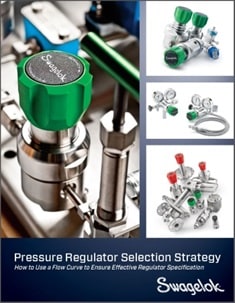Safely & Correctly Select and Size Your Next Regulator
Safely & Correctly Select and Size Your Next Regulator
We’ve covered a lot in our series on Pressure Regulators – the basic make up and function of a pressure regulator, regulator troubleshooting, and regulators for specialty applications – but we’ve yet covered the hard and fast criteria for selecting and sizing a pressure regulator for your unique application. The process of selecting the correct regulator requires definition of the application according to pressure requirements, flow rate, gas/liquid composition and temperature.
Rule of Thumb

Regulators should be sized based on the largest possible flow and the smallest change in pressure. In the event your requirements approach the limit of the regulator you’re selecting, consider using the next largest regulator available for your application.
A Note on Valve Sizing
Valve sizing means determining how much flow can pass through the pressure regulator, not the size of the end connections. Since gases are compressible and liquids are not, significant differences exist when sizing for gas and liquid regulators. We discuss consideration for gas and liquid flow, and specific gravity correction factors for gases, in our recent blog: Keep Ahead of the Curve.
Selecting a Regulator
Safely and correctly selecting a regulator requires project-specific information – no two conversations around pressure regulators are the same.
Information Needed to Quote a Regulator:
| Regulator Function | Pressure-reducing, back-pressure, specialty, etc. |
| Inlet Pressure | What are the minimum and maximum pressures, including units? |
| Outlet Pressure | How accurate do you require an outlet pressure reading (provide a range)? In what units? |
| Flow | At what inlet and outlet pressure do you require flow? In what units? Use flow curves to help you determine this, or contact us for assistance. |
| Medium | Composition of fluid – is it a gas or liquid? |
| System Compatibility | Consider the materials of construction required including the valve body, seat and diaphragm materials as well as o-rings. |
| Loading mechanism | Spring- or dome-loaded? External feedback? |
| End Connections | Specify size, spec, and pressure class. |
| Surface finish and lubrication | Specify surface finish Ra value if needed and what lubricants are preferred. |
| Options | Detail all special requirements such as certification of material, special testing, etc. as well as any additional options you require (handles, hoses, isolation valves, etc.). |
| Temperature range | Include fluid minimum and maximum temperatures as well as environmental minimum and maximum temperatures. |
All our Regulator Resources – One Click Away
With many variables to consider, selecting the correct regulator can be an intimidating task. At Swagelok, we want to ease the pressure on you. If you have unanswered questions, or are unsure how to proceed with correct product selection, our regulator subject matter experts are here to field your call.
Contact us Access Additional Resources


